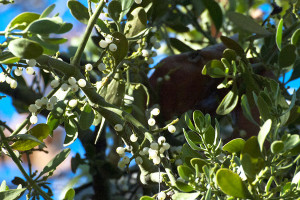Ho, ho, the mistletoe
hung where you can see…
Songs about mistletoe wafting through stores during the holiday shopping season got me wondering about mistletoe at the BFS. This time of year, when the leaves are off the Western Sycamores, you can certainly see that many of the trees are hung with mistletoe.

Clumps of Big Leaf Mistletoe (Phoradendron serotinum ssp. macrophyllum) in a Western Sycamore (Platanus racemosa) at the BFS. ©Nancy Hamlett.
But aside from decorating doorways for winter celebrations, what role does mistletoe play in the BFS ecosystem?
The mistletoe at the BFS is Phoradendron serotinum ssp. macrophyllum, known as Big Leaf Mistletoe or Colorado Desert Mistletoe. Big Leaf Mistletoe is hemiparasitic – it contains chlorophyll and fixes some carbon by photosynthesis, but it also takes some carbon from its host tree as well as all its nitrogen and water.
Mistletoe’s white berries are eaten by birds, which excrete the seeds. When mistletoe seeds have sticky substance that allow them to adhere if they land on a twig. Then the attached seed begins to develop chlorophyll and cotyledons on the top, and an embryonic root (the radicle) grows from the bottom of the seed, curves away from the light (negative phototropism), and pushes into the twig, where after a excreting an exquisitely tuned set of chemical signals, it develops a specialized structure (haustorium) within the twig that allows the mistletoe to take water and nutrients directly from the tree’s xylem and phloem.

Leaves and berries of Big Leaf Mistletoe (Phoradendron serotinum ssp. macrophyllum). ©Nancy Hamlett.
Mistletoe can harm trees by stealing water and nutrients, especially during periods of drought, when mistletoe releases large amounts of water (which all comes from the tree host) to the air. But mistletoe berries are also an important food for certain birds, such as Phainopeplas, Cedar Waxwings, and Western Bluebirds, so what is its overall effect?
Prof. David Watson and Adjunct Matthew Herring of the Institute for Land, Water and Society at Australia’s Charles Stuart University recently published a paper that addressed just this question. Using ‘cherry pickers’ and a crew of volunteers, Watson and Herring removed all the mistletoe (41 tons!) from seventeen 3 to 60-acre isolated woodland remnants. For comparison, they used eleven control sites, from which they removed an equivalent amount of foliage – but no mistletoe, and twelve sites that naturally lacked mistletoe.
After three years they surveyed birds on all the sites and found that the sites from which mistletoe had been removed had lost an average of 34.8 per cent of their woodland-dependent resident birds, 26.5 per cent of woodland-dependent bird species, and 20.9 per cent of their total species richness. In contrast, control sites showed moderate increases, while mistletoe-free sites showed no significant changes.
But perhaps the most surprising finding was that most of the decrease in bird species was not due to loss of species that forage on mistletoe, but of birds that eat insects, especially birds that eat insects on the forest floor. The authors attribute this effect to the lack of mistletoe litter, which is especially nutrient-rich. As Watson explains in an NPR interview, while regular trees “pull out the good stuff from their leaves before allowing them to fall”, mistletoes, “because they’re moochers,… don’t really care about conserving their resources – they can just suck out more” and “just drop their leaves with all the vitamins inside.” This rich litter can support more insects and thus more insect-eating birds, and possibly more reptiles and mammals, too.
Although the mistletoe species studied in Australia were different from the one found at the BFS, Daniel Nickrent, a professor of plant biology at Southern Illinois University, is quoted in the NPR interview as being convinced that the Phoradendron mistletoes play a similar role in North American forests.
Perhaps an enterprising student would like to compare arthropod diversity under trees at the BFS with and without mistletoe?
References and more information:
- Quote from “Holly Jolly Christmas” by Johnny Marks, created for the 1964 NBC production “Rudolph, The Red-Nosed Reindeer”. (Video from the program with Burl Ives singing.)
- Geils, B.W., D. Wiens, and F.G. Hawksworth. 2002. Phoradendron in Mexico and the United States. Ch. 3 in Geils, B.W.; J. Cibrián Tovar, and B. Moody, tech. coords. Mistletoes of North American Conifers. Gen. Tech. Rep. RMRS-GTR-98. Ogden, UT: U.S. Department of Agriculture, Forest Service, Rocky Mountain Research Station. p. 19-28.
- Watson, D.M., and M. Herring. 2012. Mistletoe as a keystone resource: an experimental test. Proc. R. Soc. B 279: 3853-3860.
- Mithcell, A. 17 December 2012. “Beyond the Kiss, Mistletoe Helps Feed Forests, Study Suggests.” New York Times.
- Ben-Achour, S. 27 December 2012. “Birds Hang Around Mistletoe For More Than A Kiss.” NPR.org.